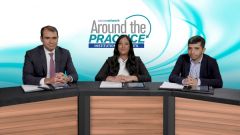
Appropriate Patient Selection for Cevostamab in Relapsed/Refractory MM
Shared insight on possible real-world applications for FcRH5-targeted bispecific antibody therapy in patients with relapsed/refractory multiple myeloma.
Episodes in this series

Transcript:
Ajai Chari, MD, PhD: Sham, what are your thoughts about which patients are the right ones to get SIBO?
Sham Mailankody, MD: For now, it's convenience and what's available, because there's only availability in the context of clinical trials. And when patients were eligible for the study, like greenness patient, I guess we also have some patients who have not had prior BCMA and gone on to Boston Lab, which I think is completely reasonable given the efficacy and the safety data. Eventually this will fall in the same area about the GPRC5G and the exact sequencing of it, we talked about three targets and three modalities. This adds to the complexity of where everything will fit in for our patients. The nice thing hopefully, is that most of our patients will eventually receive most of these treatments to be able to live a long, long and you know good quality of life.
Ajai Chari, MD, PhD: So there's that joke, right? If you ask four myeloma doctors a questions, you’ll get 5 answers. Here we can say we all want all these drugs for all our patients as quickly as possible. Right. OK. See, you need an enmity. Krina, what can you tell us about AE management with SIBO?
Krina K. Patel, MD, MSc: It's like other bispecifics. We see CRS mostly grade 1, 2, and they did have a little bit more again, neurotoxicity, which again, was grade one, but overall pretty manageable, and not anything major that you had to do with. The one thing that my patient had and what I wanted to point out, you know, most bispecifics we don't necessarily think about neutropenia being a major issue because we're not giving you know, lympho depletion chemotherapy like we do with car T or the car T themselves aren't just going in and causing problems. But occasionally, you will so about 13% of patients on this trial had grade three four neutropenia. Just so you know, my biggest thing is making sure you're monitoring for that for those of the patients, even if they have CRS. I'm also heavily looking for, you know, aggressively looking for infections and treating them you know, with GCSF, things like that.
Alfred L. Garfall, MD, MS: Yes, that's something that we saw with the teclistamab as well and it was really kind of idiosyncratic neutropenia that can come on even much later into therapy but tends to be very GCSF responsive even to very intermittent dosing at GCSF and not something that limits the ability to receive the medication. But I agree it’s not, you’re not necessarily expecting that and, AE [adverse event] this particular mechanism of action, but it does occur.
Krina K. Patel, MD, MSc: And one dose of GCSF and cm 01 went to 24 for the next day, right? They do respond really well.
Ajai Chari, MD, PhD: You guys are highlighting an important issue, which is, I think, two things. One is that even if a patient is in the CRS window, we shouldn't be forgetting about infectious complications, right in this heavily treated population. But also I want to just we haven't talked about explicitly call out a little bit about, I personally have seen unusual opportunistic viral infections, right. Which can also contribute? For example, a patient was recently unusually neutropenic and had CMV viremia reactivation. Anybody want to take a stab at you know, these viral infections, like maybe contributing to cytopenias and what your experience has been?
Krina K. Patel, MD, MSc: Yes, I can, in Texas, 90% of us are exposed to CMV. We see it quite often in our relapsed refractory patients already. But it is becoming a little bit more like post allo transplants for some of our patients getting these therapies, because they've been locally depleted with regular treatments and other immunotherapies, they are at a higher risk. Especially for my patients who have pneumonia, or eye symptoms, or things that I wouldn't necessarily usually care about. If they're on some of these novel therapies, I listened to them a little bit more carefully, and I work them up. So if they have pneumonia, I tend to send them to pulmonary to do a full workup and get a bronchoscopy check the viral, you know, it's usually not just a community acquired pneumonia, right. And for us, 30% of our car T patients have been getting CMV reactivation, we're aggressive at managing it pretty quickly, even before maybe it causes disease.
Ajai Chari, MD, PhD: Allen, anything you want to add from infection detection and monitoring?
Sham Mailankody, MD: Yes, I think as you as these drugs are going to be used more and more of the community, it's chronicity a spot on in terms of saying that, if anything doesn't make sense to craft a slightly broader net in terms of infections, you know, we talked about PCP and prophylaxis for PJP. And its prophylaxis, but also CMV, EBV, other viral infections to be mindful that some of our patients are susceptible to these infections, and therefore, and if there's those big early, they can be treated appropriately and managed appropriately. So just to have a broader differential when you're looking at unusual symptoms, infections, et cetera, in these patients, I think.
Ajai Chari, MD, PhD: We must probably say, Ajai already talked about COVID-19. And it can be more persistent, right, because the lack of clearance. I don't think there's much of a role for rechecking repeat PCR, necessarily, but at least we know that it can take a while to clear CMV EBV. Also, there's been reports of parvo. I would keep these in your back of your head, and it highlights the need for collaboration with our infectious disease colleagues, because these are not infections that our busy community oncologist is going to be used to dealing with. Working in close partnership, Sham, anything you want to add about AE management with SIBO? What are your thoughts?
Sham Mailankody, MD: Nothing specific that we've not already covered, it has kept up dosing similar to the other bispecifics. The CRS mostly grade one two there’s slightly higher reported rates of neurologic toxicities, but again, all grade one and two, neutropenia we touched on but otherwise, it has a similar profile as the other bispecifics.
Transcript edited for clarity.
Newsletter
Stay up to date on recent advances in the multidisciplinary approach to cancer.






















































































